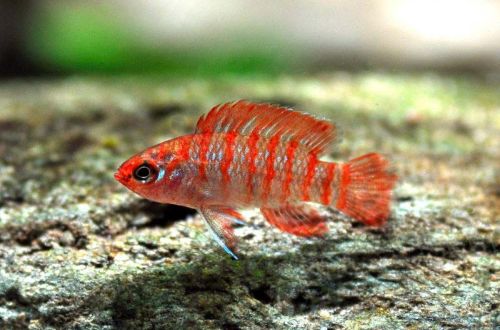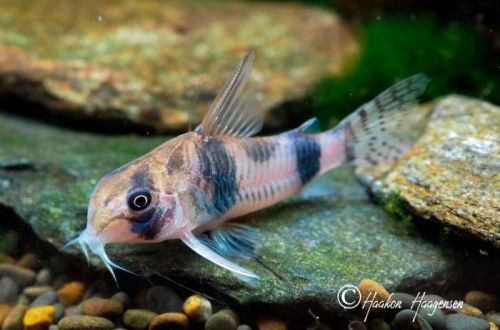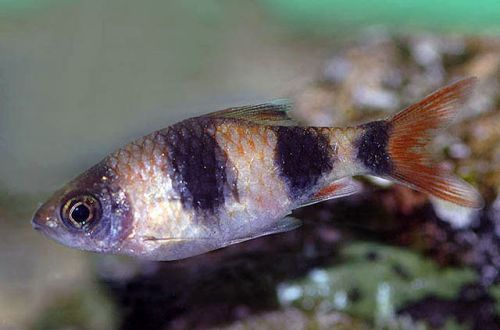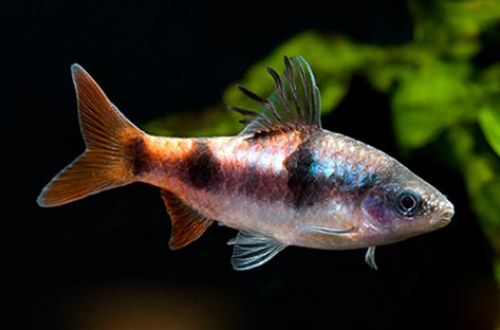
Badis Scarlet
Badis Scarlet, scientific name Dario dario, belongs to the family Badidae (Badievye). Another common name is Dario dario. Within the framework of the site, this species is assigned to the group of Labyrinth fish (Gourami and Petushki families) for ease of identification. In fact, he has a distant relationship with them through a distant ancestor, from which these families originated.

Contents
Habitat
The fish is native to Asia. It is predominantly found in India in the Brahmaputra river basin. Inhabits small rivers with clean running water with sandy or gravel substrates and dense thickets of plants along the shore. In the habitats of this species, you can see such popular aquarium plants as Wallisneria, Hygrophiles, Limnophiles, Rotals, Ottelia and others.
Description
These are very small fish. The sizes of adult males rarely exceed 2 cm, and females 1.5 cm. In addition to size, males are distinguished by a bright red color with blue vertical pigmentation on the sides. The blue color is also present on the fins. The females are grey. Dark stripes are sometimes traced in the body pattern.
Behavior and Compatibility
Due to its size, Badis Scarlet will not be able to live with large and aggressive fish. The problem will also be active neighbors in the aquarium, which will be the main competitors for food.
Intraspecific relationships are similar to those of Betta fish. Males are hostile towards each other and in small tanks they will certainly arrange skirmishes for territory and females. For this reason, it is recommended to purchase one male in a company of several females.
It is acceptable to keep several groups of males in spacious aquariums with a well-planned design – the presence of various spawning sites equally distant from each other.
Brief information:
- The volume of the aquarium – from 40 liters.
- Temperature – 18-26°C
- Value pH — 6.5–8.5
- Water hardness – 5–20 dGH
- Substrate type – any soft
- Lighting – subdued
- Brackish water – no
- Water movement – little or no
- Fish size – up to 2 cm
- Feeding – any food of suitable size
- Temperament – peaceful
- Content – in a small aquarium in a pair of male / female or in a harem
Maintenance and care, arrangement of aquariums
For a small group of fish in the amount of 3-4 individuals, an aquarium with a volume of 40 liters or more is sufficient. The design uses a soft substrate and many aquatic plants. A good choice would be the species that grow in their natural habitat, which are mentioned above, as well as Cryptocoryne, Anubias, various mosses and ferns. A useful addition are natural snags and leaves of some trees.
In long-term management, it is important to avoid the accumulation of organic waste that can reduce water quality and lead to sharp fluctuations in pH and GH. This is especially true for small aquariums.
The key to clean water will be the smooth operation of the filtration system and regular maintenance of the aquarium. In particular, it is necessary to replace part of the water with fresh weekly, combined with the procedure for cleaning the soil from fish waste, uneaten food residues, etc.
Food
In nature, they feed on small zooplankton. In a home aquarium, it is desirable to serve similar products, for example, daphnia, brine shrimp in dry, freeze-dried, frozen or live form. Can be accustomed to dry food (flakes, granules).
It is noted that Dario dario are prone to obesity when fed with bloodworms, which subsequently increases the risk of disease.
Breeding / breeding
In favorable conditions, the appearance of offspring is possible in the main aquarium. For breeding, it is desirable to use one pair or a harem of a male and several females. If there are several males, it is likely that one of them will become dominant and it will be he who will participate in reproduction.

With the onset of the spawning period, the male begins courtship, which can last several days. As a rule, the female lays eggs on the underside of a leaf of a plant, and then swims away. The male remains near the clutch, protecting the surrounding area until the fry appear.
The incubation period lasts 2-3 days. During the next week, the fry feed on the remains of their yolk sac and only then begin to swim freely in search of food. The fry are very small and can only take tiny food. First ciliates, then brine shrimp nauplii, or specialized powders and suspensions for feeding juvenile aquarium fish. Feeding is more convenient to do in a separate tank.
Sources: wikipedia.org, fishbase.se





